
As dog owners, we love treating our furry friends to something special.
But when it comes to food, what’s safe for humans isn’t always safe for dogs.
This brings us to a common household favorite: honey.
It’s sweet, natural, and full of health benefits for humans, but can dogs have honey too?
In this post, we’ll dive deep into the potential benefits and risks of honey for your dog, helping you decide if this sweet treat is worth sharing with your canine companion.
What Is Honey and Why Do Humans Love It?
Honey is a natural sweetener packed with glucose, antioxidants, vitamins, and minerals.
Humans have been using honey for centuries as a remedy for everything from sore throats to skin conditions.
It’s valued for its anti-inflammatory properties, ability to soothe, and natural energy boost.
But just because honey is a superfood for us doesn’t automatically mean it’s safe for dogs.
So, before you drizzle some over your pup’s food, let’s explore whether honey can be a safe treat for your dog.
Is Honey Safe for Dogs?
Yes, dogs can have honey, but only in moderation. While honey offers some benefits, it also comes with risks, especially for certain dogs.
Potential Risks of Honey for Dogs
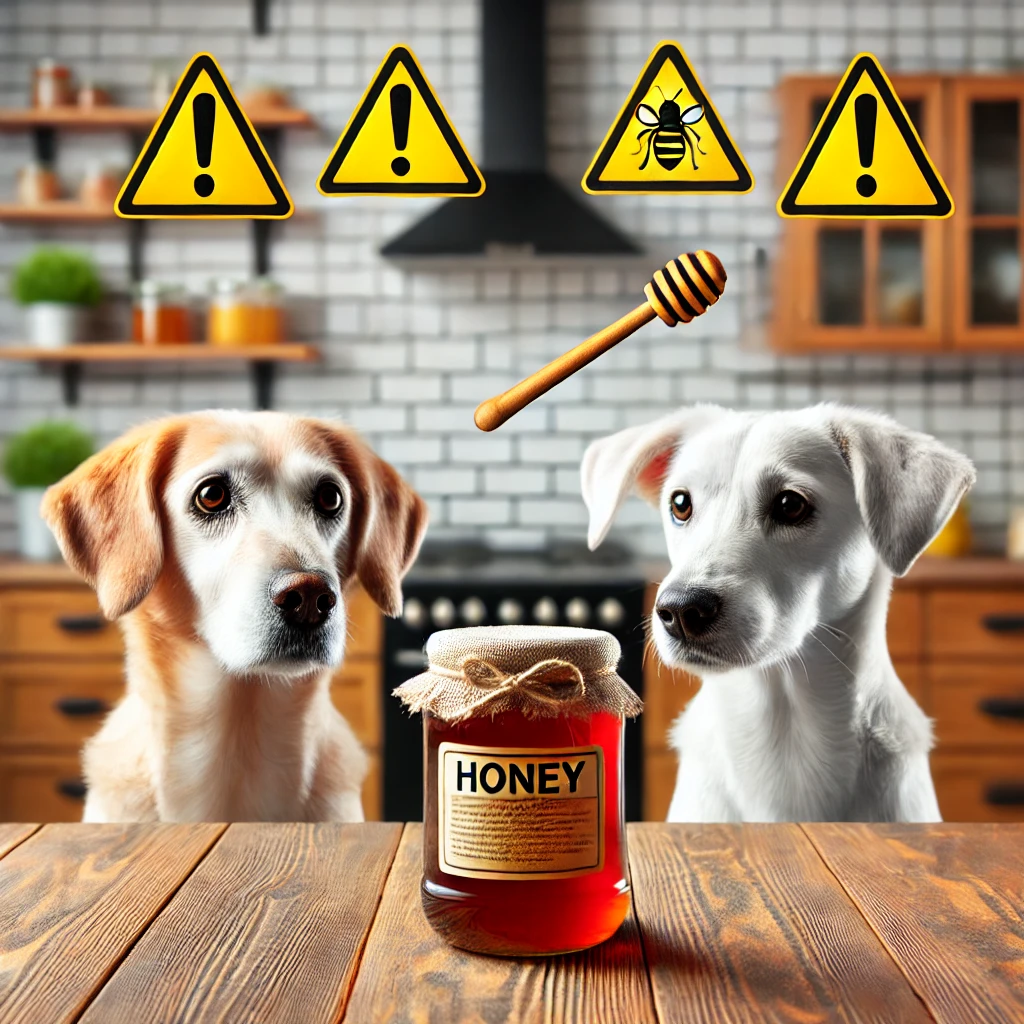
While honey can offer some benefits, it also comes with potential risks, especially when given in large quantities or to certain dogs.
Here’s a deeper look at the risks associated with feeding honey to your canine companion:
1. High Sugar Content
Honey is rich in natural sugars, primarily glucose and fructose, which can pose a problem for dogs.
Although these sugars are unprocessed and natural, they still contribute to calorie intake and can lead to various health problems if consumed excessively.
Here are some specific concerns related to the high sugar content in honey:
- Weight Gain: Even small amounts of honey contain a significant amount of sugar, which can contribute to weight gain if fed regularly. Obesity in dogs is a growing issue, leading to problems such as joint pain, reduced mobility, and a decreased quality of life. For breeds that are prone to weight issues or dogs that already have difficulty managing their weight, feeding honey could exacerbate the problem.
- Diabetes Risk: Dogs that are overweight or have a predisposition to diabetes should avoid sugary foods like honey. The excessive sugar in honey can cause blood sugar spikes, worsening or leading to insulin resistance. Dogs that are already diagnosed with diabetes should avoid honey altogether, as even small amounts can be detrimental to their health.
- Dental Problems: Just like humans, dogs can develop dental issues from consuming too much sugar. Feeding honey too frequently can lead to tooth decay, plaque buildup, and gum disease. If you do decide to give honey occasionally, it’s essential to maintain a good dental hygiene routine for your dog, including regular tooth brushing or using dental chews that help clean teeth.
2. Risk of Botulism (Especially in Puppies)
Raw or unpasteurized honey may contain Clostridium botulinum spores, a bacteria that can cause botulism.
This is especially dangerous for puppies under one year old and dogs with weakened immune systems. Here’s why:
- Botulism in Puppies: Puppies have immature immune systems, which makes them more vulnerable to bacterial infections. Botulism can cause serious symptoms, such as muscle weakness, difficulty breathing, paralysis, and in severe cases, death. For this reason, honey should be completely avoided in puppies under one year old.
- Immunocompromised Dogs: Dogs with weakened immune systems, whether due to illness, medications, or old age, are also at higher risk of contracting botulism from raw honey. In these cases, it’s best to err on the side of caution and avoid honey altogether.
3. Allergic Reactions
While rare, some dogs may have allergic reactions to honey.
This can be due to the pollen content or other natural compounds found in honey.
If your dog has never had honey before, it’s important to introduce it slowly and monitor for any signs of an allergic reaction, including:
- Itching or Skin Irritation: Some dogs may develop itchy skin, hives, or rashes after consuming honey.
- Swelling: Swelling of the face, ears, lips, or even limbs can occur as part of an allergic reaction.
- Gastrointestinal Issues: Vomiting, diarrhea, or an upset stomach can occur if your dog has an intolerance or allergy to honey.
- Respiratory Distress: In severe cases, dogs may experience difficulty breathing or other respiratory issues, which require immediate veterinary attention.
4. Gastrointestinal Upset
While honey is generally well tolerated in small amounts, feeding too much at once can lead to gastrointestinal upset.
This includes:
- Diarrhea: The high sugar content can cause an imbalance in your dog’s digestive system, leading to diarrhea.
- Vomiting: Some dogs may experience vomiting if they consume honey too quickly or in excessive amounts.
- Bloating or Gas: The rich sweetness of honey can lead to gas or bloating in dogs, especially if their stomachs aren’t used to digesting sugary foods.
If your dog shows any signs of digestive distress after consuming honey, it’s best to discontinue feeding it and consult your veterinarian.
5. Risk of Overfeeding
Because honey is sweet and dogs tend to love it, there’s a risk of overfeeding if you’re not careful.
It’s easy to give in to those puppy-dog eyes, but doing so could quickly turn a rare treat into a regular, unhealthy habit.
Overfeeding honey can lead to:
- Obesity: As mentioned earlier, the caloric density of honey can quickly contribute to weight gain.
- Pancreatitis: Feeding too much honey or other sugary, fatty foods can increase the risk of pancreatitis, a painful and potentially life-threatening condition in dogs.
- Behavioral Issues: Dogs that are regularly given sugary treats like honey may start to demand more of it, leading to begging behavior or even food aggression.
6. Exacerbating Existing Health Conditions
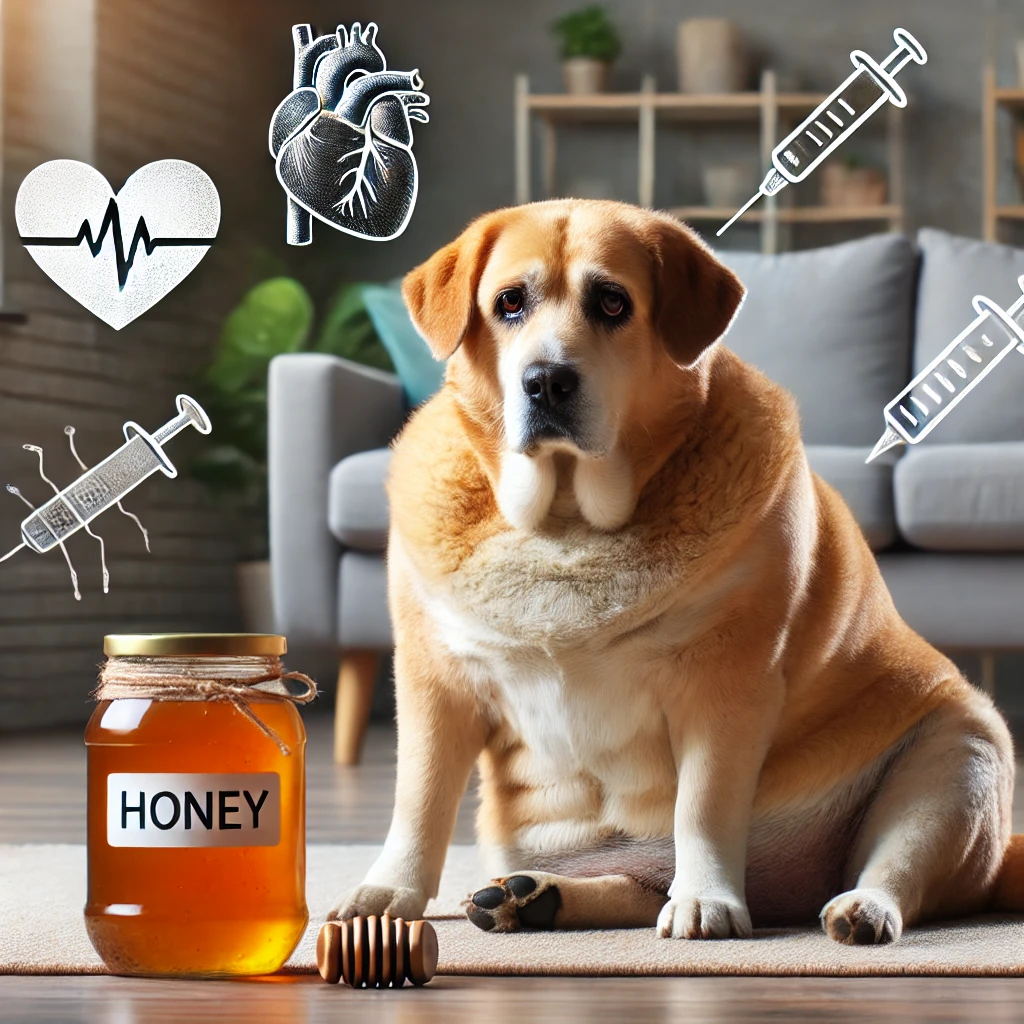
If your dog has an underlying health condition, such as obesity, diabetes, or allergies, honey could make things worse.
For example:
- Diabetic Dogs: Even small amounts of honey can cause dangerous blood sugar spikes in diabetic dogs, leading to complications like lethargy, excessive thirst, and seizures. It’s crucial that diabetic dogs avoid honey and other sugary foods entirely.
- Overweight or Obese Dogs: Dogs that are already struggling with weight issues should not be given honey, as it adds unnecessary calories and sugar to their diet.
- Dogs with Pancreatitis: Pancreatitis is an inflammation of the pancreas that can be triggered by high-fat or sugary foods. Honey could increase the risk of flare-ups in dogs that are predisposed to this condition.
7. Unintentional Over-sweetening
Finally, honey should not be a go-to sweetener in your dog’s diet.
There are many other healthy, dog-friendly alternatives that can provide sweetness and nutritional benefits without the high sugar content.
Feeding your dog too much honey or using it regularly as a sweetener can mask healthier food choices, leading to poor dietary habits over time.
Summary
While honey can offer some health benefits in small quantities, the potential risks—especially related to its high sugar content, the risk of botulism, allergic reactions, and gastrointestinal upset—mean that it should be given cautiously and only occasionally.
Dogs with diabetes, obesity, or weakened immune systems should avoid honey entirely to prevent complications.
Always consult with your vet before introducing honey or any new food into your dog’s diet to ensure it’s safe for your furry friend.
The Benefits of Honey for Dogs
In small amounts, honey can provide several health benefits for dogs. Here are a few:
- Natural Energy Boost: Thanks to the glucose in honey, it can be a quick energy source for active dogs.
- Soothes Sore Throats: Honey has natural anti-inflammatory properties, which can help soothe minor throat irritation in dogs, much like it does in humans.
- Allergy Relief: Some pet owners report that local honey can help alleviate seasonal allergies in dogs. The idea is that small amounts of pollen found in local honey can help desensitize your dog’s immune system.
- Antioxidant Benefits: Honey is rich in antioxidants, which can support your dog’s overall immune system and help fight off free radicals.
Safe Serving Size
A small teaspoon of honey occasionally can be a safe treat for most dogs, but it should never become a daily snack.
Always introduce new foods slowly to watch for any adverse reactions.
When to Avoid Giving Your Dog Honey
There are specific cases where honey is not recommended for dogs.
For instance, puppies under a year old should not be given honey due to their developing immune systems, which may not be able to handle the bacteria found in raw honey.
Additionally, dogs with diabetes, obesity, or weakened immune systems should steer clear of honey, as the sugar content can complicate their health issues.
Signs of Honey Intolerance in Dogs
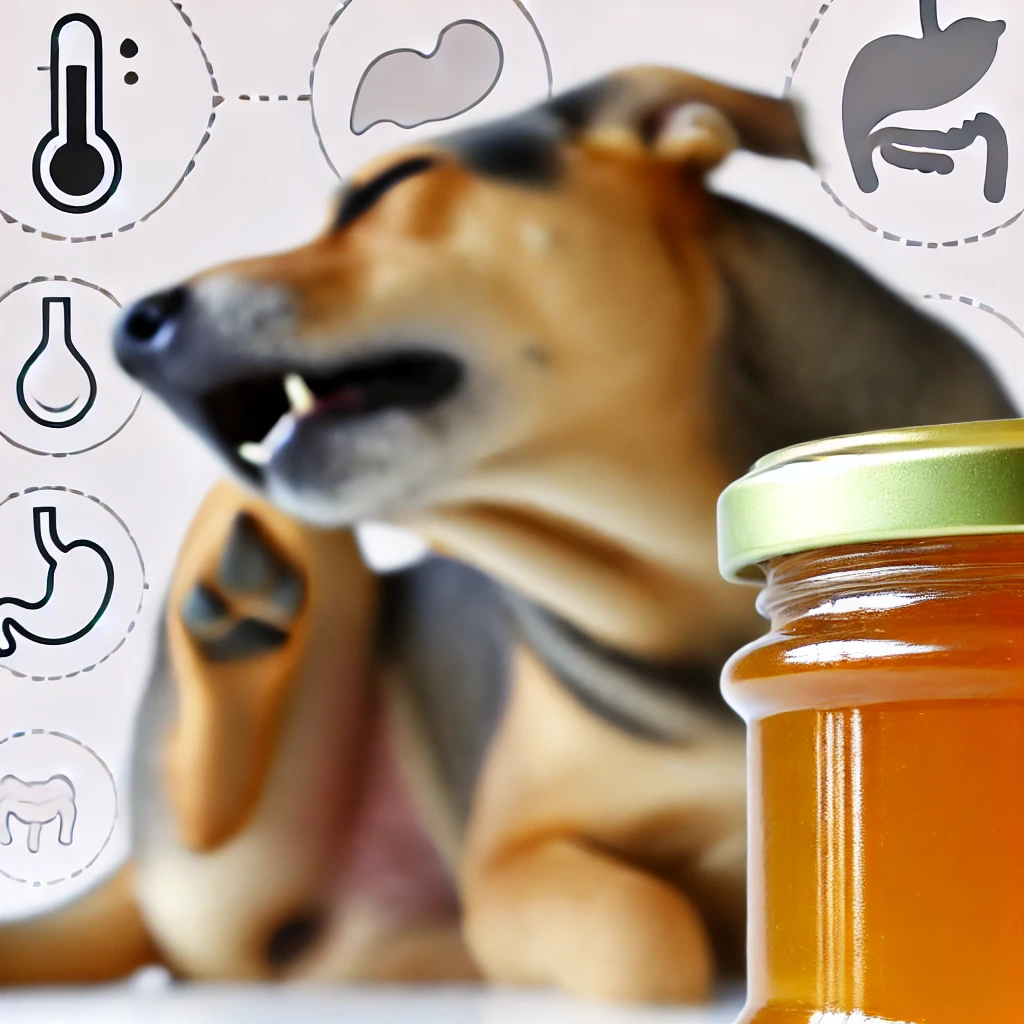
If you decide to introduce honey into your dog’s diet, it’s important to monitor for any signs of intolerance.
While honey is generally safe for most dogs in small amounts, some may experience adverse reactions.
These signs can vary from mild digestive upset to more severe allergic responses.
Here’s a detailed breakdown of the potential signs of honey intolerance in dogs:
1. Gastrointestinal Issues
One of the most common signs of honey intolerance is digestive upset.
Since honey contains natural sugars, some dogs may struggle to digest it properly, especially if they have sensitive stomachs.
The following symptoms might indicate your dog is having trouble processing honey:
- Diarrhea: Honey’s high sugar content can overwhelm your dog’s digestive system, leading to loose stools or diarrhea. If you notice frequent or watery stools after your dog consumes honey, it’s a strong indication of intolerance.
- Vomiting: Some dogs may vomit after eating honey, especially if they are unaccustomed to sweet, sugary foods. Vomiting can occur shortly after consumption or a few hours later as your dog’s body tries to expel the substance.
- Bloating or Gas: If your dog experiences bloating, excessive gas, or discomfort after eating honey, it could be a sign that their digestive system is reacting poorly to the sugars. Bloating can sometimes be accompanied by visible swelling of the abdomen or signs of discomfort, like pacing or whining.
- Constipation: In some cases, honey might lead to constipation rather than diarrhea. If your dog is straining during bowel movements or hasn’t defecated in a while after consuming honey, it could be a sign that honey isn’t agreeing with their digestive system.
2. Lethargy and Fatigue
If your dog becomes unusually tired or lethargic after eating honey, it could be a sign that their body is having difficulty processing the sugars.
While honey provides a quick energy boost due to its glucose content, dogs with honey intolerance may experience an energy crash after the initial spike.
This could manifest as:
- Unusual fatigue: Your dog may seem sluggish, less interested in activities, or sleep more than usual.
- Lack of enthusiasm for play: If your typically energetic dog shows little interest in toys, play, or walks, this could be a subtle sign of an energy imbalance caused by the honey.
- General weakness: In more severe cases, honey intolerance can lead to a feeling of weakness, where your dog might appear wobbly or reluctant to move.
3. Increased Thirst and Urination
Because honey is high in sugar, it can cause an increase in your dog’s blood sugar levels.
In some dogs, particularly those with pre-existing conditions like diabetes or obesity, honey may trigger excessive thirst (polydipsia) and urination (polyuria).
Signs to watch for include:
- Frequent water consumption: If your dog starts drinking water excessively after consuming honey, this could be their body’s way of trying to dilute the sugars and maintain balance.
- Increased urination: Along with excessive drinking, your dog may need to urinate more frequently, sometimes even having accidents in the house if they can’t hold it. This is often a sign that the sugar in honey has triggered an imbalance in your dog’s system.
4. Allergic Reactions
While honey allergies are rare in dogs, they are still possible.
Some dogs may have an allergic reaction to pollen or other trace elements found in honey, particularly raw or unpasteurized varieties.
Signs of an allergic reaction include:
- Itchy skin: Your dog may start scratching more than usual, especially around the face, ears, and paws. Allergic reactions to honey can cause localized or full-body itching.
- Hives or Swelling: Hives (raised bumps on the skin) can appear after an allergic reaction. Swelling is another common allergic response, particularly around the face, lips, or eyelids.
- Respiratory distress: In severe cases, an allergic reaction to honey could cause breathing difficulties. If your dog is wheezing, coughing, or has labored breathing after consuming honey, this requires immediate veterinary attention.
- Runny nose or watery eyes: Just like humans, dogs can show allergy symptoms through nasal discharge or watery eyes, particularly if the honey contains pollen that their immune system reacts to.
5. Behavioral Changes
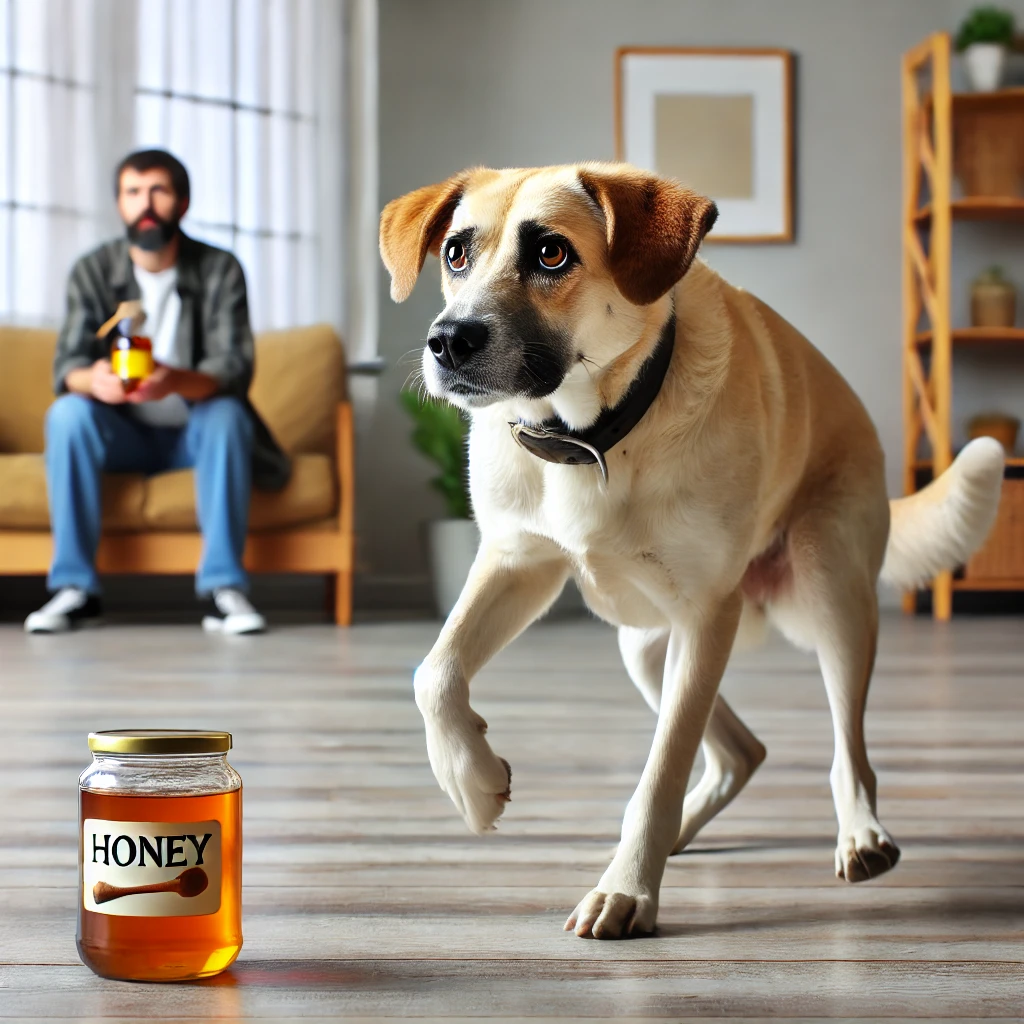
Some dogs may exhibit behavioral changes after consuming honey, which can be a subtle sign of discomfort or intolerance.
These changes may include:
- Restlessness: If your dog becomes unusually restless, pacing, or unable to settle down after consuming honey, it may indicate that the honey is causing discomfort or triggering a mild allergic response.
- Irritability: Intolerance to honey can sometimes make dogs more irritable or anxious, particularly if they’re experiencing physical discomfort that they cannot communicate.
- Withdrawal from interactions: If your dog typically enjoys socializing but seems withdrawn or disinterested in family activities after eating honey, this could signal that something is off.
6. Excessive Drooling
Excessive drooling (hypersalivation) can occur when dogs are experiencing nausea, irritation in the mouth, or digestive discomfort.
If you notice your dog drooling more than usual after consuming honey, this may be a sign that the honey has upset their stomach or is causing oral discomfort.
7. Dehydration
Honey can sometimes lead to dehydration in dogs, especially if it causes gastrointestinal issues like vomiting or diarrhea.
Signs of dehydration in dogs include:
- Dry gums or nose: If your dog’s gums or nose feel dry to the touch, this could indicate they are dehydrated.
- Sunken eyes: Dehydrated dogs may have sunken eyes or appear tired and listless.
- Loss of skin elasticity: You can perform a simple skin test by gently pinching a small amount of your dog’s skin between your fingers. If the skin doesn’t quickly return to its normal position, your dog may be dehydrated.
8. Hyperactivity (Sugar Rush)
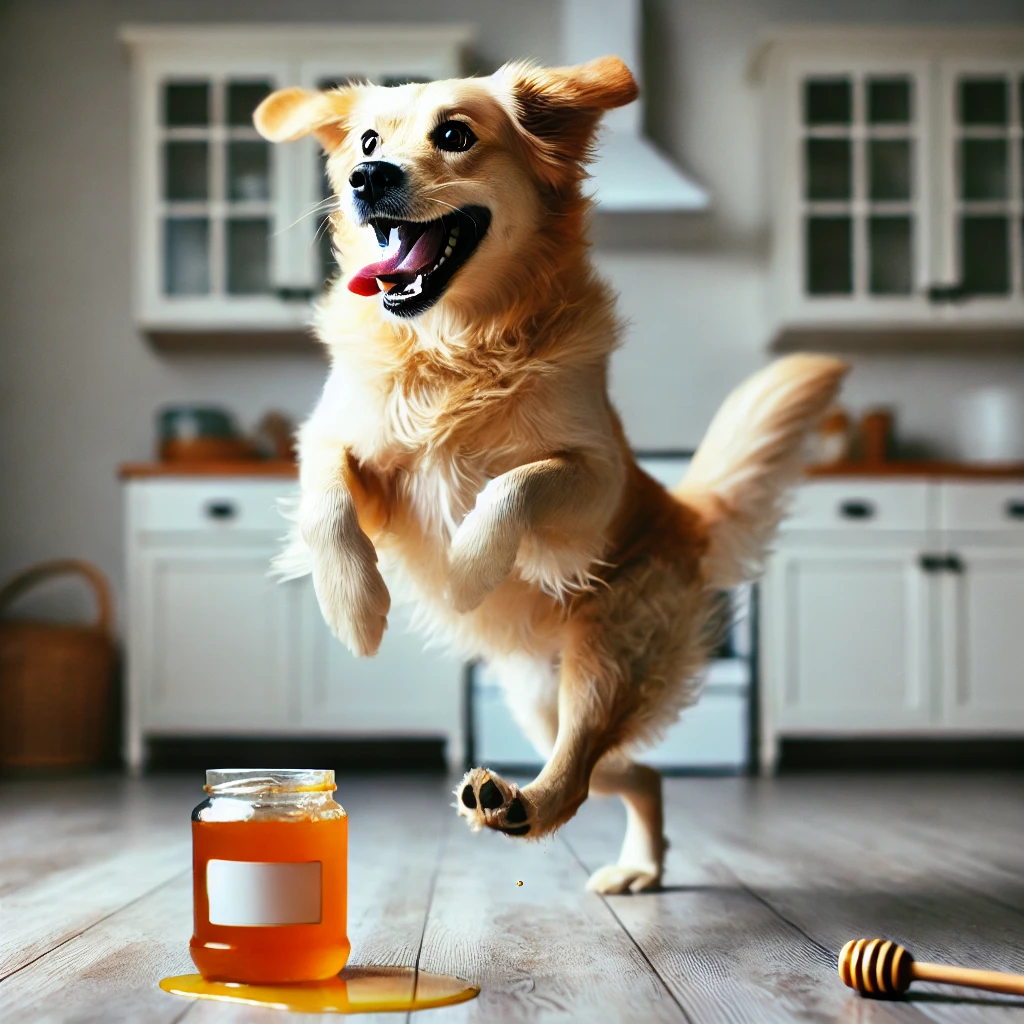
In some dogs, the high sugar content of honey can cause a short-term burst of energy or hyperactivity.
This is often followed by a “crash,” where the dog becomes lethargic or irritable. Signs of hyperactivity include:
- Excessive running or zoomies: If your dog suddenly gets a burst of energy and starts running around the house or yard frantically, this could be due to the sugar spike from the honey.
- Inability to settle down: A dog that can’t seem to calm down or constantly wants to play after eating honey may be experiencing a sugar rush.
9. Paw Licking or Biting
Paw licking or biting is a common response in dogs with food allergies or intolerances.
If you notice your dog excessively licking their paws or biting at them after consuming honey, it may be a sign that their body is reacting negatively to the sugar or pollen in honey.
10. Changes in Appetite
Finally, changes in your dog’s appetite could also be a sign of honey intolerance:
- Decreased appetite: If your dog suddenly loses interest in food after consuming honey, it may be a sign of gastrointestinal discomfort or nausea.
- Increased appetite (sugar cravings): On the flip side, honey’s sugar content may trigger an increased desire for more sugary foods. Some dogs may beg or show unusual interest in sweet foods after tasting honey, but it’s important not to indulge this behavior, as too much honey can be harmful.
What to Do If Your Dog Shows Signs of Honey Intolerance

If your dog displays any of these signs after consuming honey, it’s important to stop giving them honey immediately.
In most cases, symptoms of honey intolerance will subside once the honey is out of their system.
However, if your dog experiences severe symptoms like vomiting, diarrhea, swelling, or difficulty breathing, contact your veterinarian right away for guidance.
For milder symptoms, offering your dog plenty of water and monitoring them for improvement may help.
It’s always a good idea to introduce any new food, including honey, in small amounts and observe how your dog reacts before incorporating it into their diet regularly.
How to Serve Honey to Your Dog Safely
If you decide to give honey a try, there are several ways to safely serve it:
- Plain, small portions: A teaspoon as a snack or a reward.
- Drizzled over dog-safe fruit: For example, serve a small amount of honey over dog-safe fruits like apples or bananas for a treat.
- Mix into food: Add a small teaspoon into your dog’s food to see if they enjoy the added sweetness.
- In homemade treats: You can use honey as an ingredient in homemade dog treats. Here’s a simple recipe:
Simple Honey Dog Treat Recipe
- Ingredients:
- 1 cup of rolled oats
- 1/2 cup of unsweetened applesauce
- 1 tablespoon of honey
- Instructions:
- Preheat your oven to 350°F (175°C).
- Mix all ingredients in a bowl until well combined.
- Scoop spoonfuls of the mixture onto a lined baking sheet.
- Bake for 10-12 minutes, or until golden brown.
- Let the treats cool before serving to your dog.
Recommended Honey-Based Products for Dogs
If you want to incorporate honey into your dog’s diet safely, here are some options that can be found online:
- Dog Treats with Honey: Opt for high-quality treats that use honey as a natural ingredient, and check that they’re specially formulated for dogs.
- Honey-Infused Dog Chews: Look for dental chews infused with honey to combine oral care with a tasty treat.
- Honey Dog Supplements: You can find supplements designed for dogs that contain honey, helping boost their immune system and energy levels.
These products provide a controlled amount of honey, ensuring your dog enjoys the benefits without any risks.
Alternatives to Honey
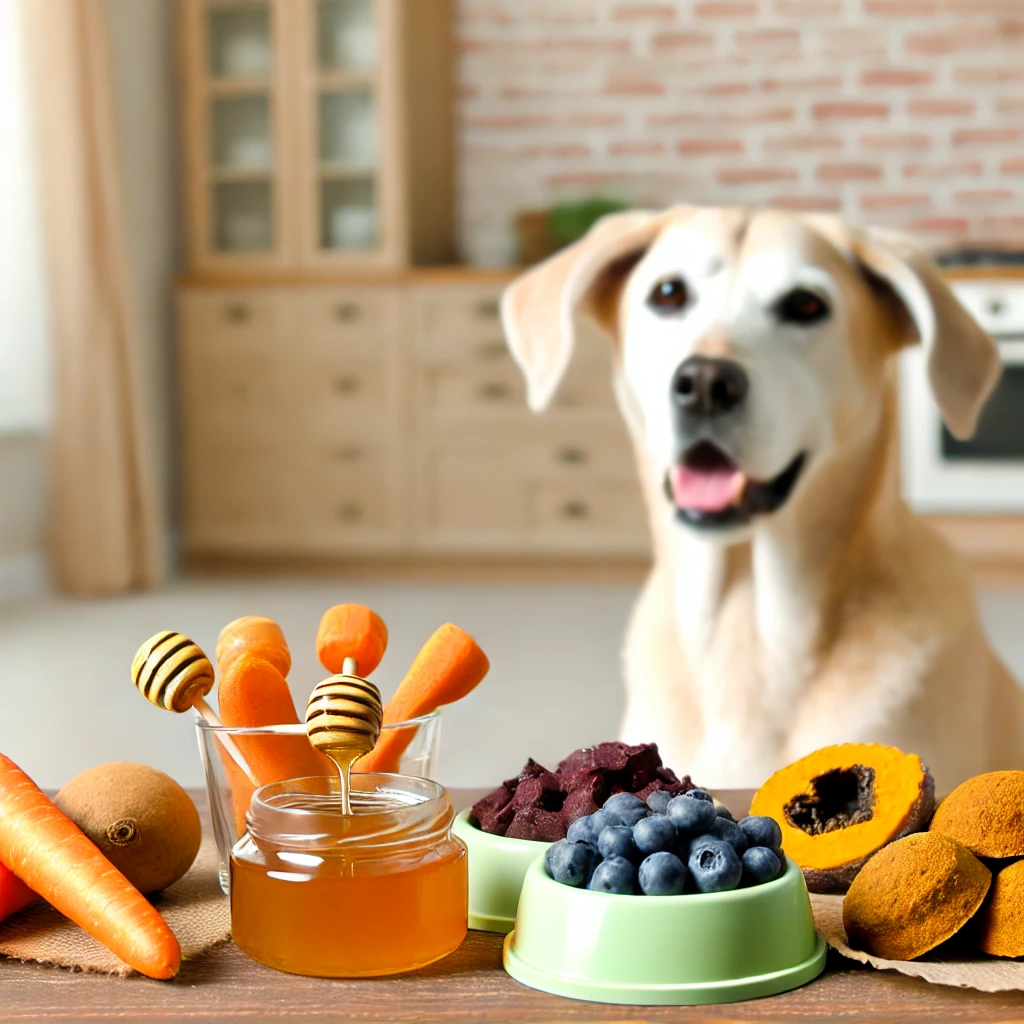
If you’re still unsure about giving honey to your dog, there are plenty of other sweet, natural treats you can consider:
- Carrots: Naturally sweet and full of fiber, carrots make an excellent alternative treat for dogs.
- Blueberries: Packed with antioxidants, blueberries are a healthy snack option.
- Pumpkin Puree: Full of fiber and low in sugar, pumpkin is great for digestive health and a tasty addition to your dog’s diet.
Conclusion
So, can dogs have honey?
Yes, but with caution.
Honey can be a sweet treat that offers health benefits like boosting energy and soothing sore throats.
However, it’s important to serve it in moderation and avoid giving it to dogs with certain health conditions.
Always check with your vet before introducing new foods into your dog’s diet, and if in doubt, stick to dog-friendly alternatives.
Does your dog love honey?
Let us know in the comments below, and feel free to share this post with fellow pet owners who may be curious about this sweet treat!
Frequently Asked Questions (FAQ)
- Can dogs eat raw honey?
- Yes, but it’s safer to give pasteurized honey to avoid the risk of botulism, especially in puppies.
- Can honey help with my dog’s allergies?
- Some dog owners report that local honey can help reduce seasonal allergy symptoms. However, results vary, and it’s best to consult your vet.
- How much honey is safe for my dog?
- A teaspoon or less on occasion is safe for most dogs.
- Is honey safe for puppies?
- No, it’s best to avoid honey for puppies under a year old due to the risk of botulism.
Related Articles:
Is Cinnamon Bad for Dogs? How Much Is Too Much?
Are Tomatoes Bad for Dogs? Learn When It’s Safe and When It’s Not
As an Amazon Associate I earn from qualifying purchases.



